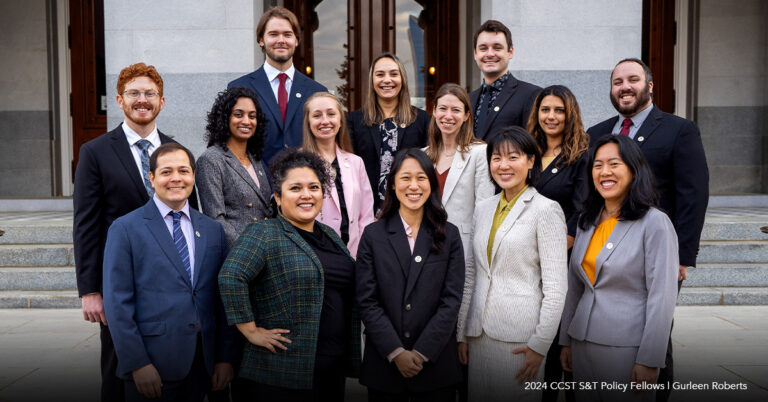Update: Applications for the CCST Science & Technology Policy Fellowship Have Closed
California’s High-Tech Leadership Driven by Diverse Regional Innovation Ecosystems
March 10, 2015 | CCST Newsroom | Contact: M. Daniel DeCillis

California, one of the nation’s leading science and technology states, was one of the hardest hit states in the country during the recent economic recession. The state lost 1.3 million jobs and faced years of government deficits which forced difficult decisions on programs and infrastructure essential to its high-tech economy. But despite the challenges, California remains one of the top environments for high-tech innovation, due in part to the different strengths of three key regions in the state.
“California’s innovation capacity comprises a powerful story,” said CCST Executive Director Susan Hackwood. “The similarities between the high-tech communities in San Diego, Los Angeles, and the Bay Area are striking, but the differences are just as much so.”
The innovation ‘ecosystem’ is the complicated interplay of numerous factors in the environment which help foster and nurture high-tech innovation including research and development spending, venture capital, the talent pool, and many more. There has been considerable focus in recent years on identifying and supporting key factors to boost the growth of high-tech innovation in the U.S. and abroad.
“You need a fluid flow of people, information, and ideas across institutional and organizational boundaries,” said Jim Wunderman, President & CEO of the Bay Area Council, a business-supported public policy advocacy organization in the Bay Area. “Successful models tend to include a combination of local cross-institutional partnerships, collaboration with networks and resources both within the region and elsewhere, and a quality of life that is culturally flexible and has the ability to attract and retain talent.”
The Bay Area, home to Silicon Valley, is the national benchmark for high-tech innovation; the region is home to a wealth of research universities, federal laboratories, and corporations which actively collaborate in numerous ways.
“The partnerships are both formal and informal, offering a flexible environment which effectively leverages the Bay Area’s considerable resources,” said Wunderman. “And this is appealing to the private sector: in 2013, 45% of U.S. venture capital investment took place in the Bay Area.”
While the Bay Area is the best known of California’s high-tech innovation centers, it is not, however, the only one. San Diego has a substantial innovation economy as well, adding 412 new technology businesses in 2013, according to Connect, a regional group that aims to promote and create technology-based companies. In 2013 San Diego County received more than 6,700 patents, the third-highest county total in the state.
“San Diego is an interesting case study, as it has a topography and geography unsuited to large scale industrial development,” said Mary Walshok, Associate Vice Chancellor of Public Programs and Dean of Extended Studies at the University of California, San Diego. “The area has pursued a collaborative, deliberate community strategy to build the economy, focusing on land use decisions designed to attract the military and support R&D for national defense.”
San Diego’s persistent branding and promoting of the region’s science and technology companies, along with an early recognition of the importance of creating an ecosystem that could enable commercialism, have helped drive thriving centers for both biotech and software research.
“A broad cross-section of the regional economy participates with both their time and capital in assuring that the innovation ecosystem works,” said Walshok.
The Los Angeles area represents still another model of an innovation-friendly ecosystem. While the Bay Area and San Diego have long relied on the high-tech sector as engines of their economies, Los Angeles has an economy that is transitioning towards newer industries. In 2013 the local tech sector edged out the area’s manufacturing, food services, and trade and logistics industries for the first time, with jobs spread out across a wide range of industries including aerospace, technical consulting, engineering services, and computer software.
“There are a lot of misperceptions about Los Angeles,” said Amy Amsterdam, of the Los Angeles County Economic Development Corporation. “It does face challenges such as sprawl and access to capital which other high-tech urban areas do not. However, L.A. county is home to the busiest port in the Western hemisphere and the largest manufacturing center in the U.S., and is also the number one county in the U.S. for PhDs.”
The regional success stories of the Bay Area, Los Angeles, and San Diego have been a driving force in California’s economic recovery. Not surprisingly, the state is prioritizing the commercialization of innovation and technology as an economic development strategy, launching an innovation hub program in 2014 (iHub) with sixteen hubs around the state, seeking to expand.
Challenges remain. In a 2011 assessment of California’s innovation ecosystem, CCST found that many stakeholders in the science and technology community were concerned about key underpinnings of the state’s ability to remain a high-tech leader in the future, in particular the state’s approach to incorporating digitally enhanced education and the infrastructure and resource limitations posed by the state’s water systems. Addressing these will be a long-term challenge for the state. However, while California’s size makes such issues more difficult to deal with, it is also a key to its long-term success as an innovation leader.
“There is no single development model,” said Wunderman. “Every city, every region, has its own unique potential.”






